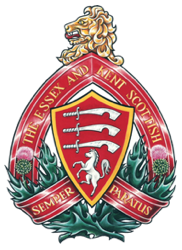Ross Munro, War Correspondent

A photograph of Ross Munro delivering a speech to the families of those who perished or were captured at the battle of Dieppe
Ross Munro, OBE, was a journalist who acted as a Canadian war correspondent during World War II. He began his career as a journalist with the Canadian Press in 1936 after attending university. He worked in the Ottawa Bureaus in Ottawa and Washington before going overseas in 1940. He covered the Canadian army for five years.
His first assignment was to cover a flotilla of American destroyers that were leased to Britain in 1940. He later went on to cover the Allied occupation of the arctic island of Spitzbergen in 1941. He was soon drawn to the Essex Scottish as they were training in England due to their “congenial” nature and their ability to be forthcoming with information. He described the Essex Scottish as the “prime” regiment of the Second World War, and that their highland traditions made them a desirable unit to join.
Munro covered the Essex Scottish Regiment’s training in England, particularly in Sussex and Surrey in the south of England. He also reported on the regiment’s training on the Isle of Wight just before the Dieppe Raid. He was supposed to be with the Essex Scottish for its original deployment at Dieppe, Operation RUTTER in July 1942 but it was rescheduled, and Monroe was sent to cover the Royal Regiment of Canada from Toronto instead.
He described the Dieppe Raid battle as a “shambles” which failed because the men lacked experience on the battlefield. Munro argued that Vice Admiral Mountbatten, who planned the Combined Forces operation, did not take this into account before sending them on the Raid. He remembered seeing the Essex Scottish land at Red Beach, but lost sight of them after that. He was embedded with the Royal Regiment during the battle and was present when they were decimated on Blue Beach. When Munro returned to England after Dieppe, he visited each regiment that participated in the battle and got detailed accounts of what happened. They were published in the Windsor Daily Star and other newspapers the next day. He stated in a later interview that the Essex Scottish Regiment was in “pretty grim spirits” after the battle. However, censorship on Canadian reporting at the time meant that Munro’s harrowing experiences at Dieppe were covered up and sanitized to illustrate a Canadian victory. Munro was also tasked with telling the soldiers and their families home in Windsor about the raid seven days after the tragedy at Dieppe. He returned to Europe and covered the invasion of Sicily and mainland Italy in 1943, as well as the Battle of Normandy in June 1944. Munro noted that he thought the Essex Scottish’s return to Dieppe in 1944 was one of the best things that happened to the regiment during the war. He described the outpouring of gratitude for the regiment in Dieppe as the French people threw flower bouquets at the soldiers. In Belgium, an old woman even threw a cooked chicken in his armoured car!
Throughout his travels, Munro was well-liked. Halfway through the war, the Essex Scottish allowed Munro to wear their hat badge, an honour few outside the regiment received.
Munro returned to Canada in 1948 after covering western Europe for the Canadian Press. This included the Nuremberg Trials, where he became acquainted with Lieutenant-Colonel Bruce MacDonald of the Essex Scottish Regiment. He published a book about his war experiences, Gauntlet to Overlord, in 1945. The book won the Governor General’s Award. Looking back on his time overseas during the war, he stated that as a newspaper man, he was lucky to be there. Munro later expressed praise for the Essex Scottish Regiment, stating that if anyone spoke ill of the Scottish then he would give them the back of his hand.
Story by Nicole Pillon, Canada Summer Jobs 2022 participant
with The Essex and Kent Scottish Regiment Association
Sources
- Ross Munro Interview for Duty Nobly Done
- W.L. McGregor Interview for Duty Nobly Done
- Canada from Afar: The Daily Telegraph Book of Canadian Obituaries, edited by David Twiston Davies (1996)
